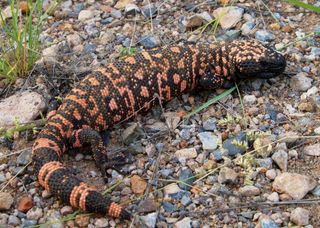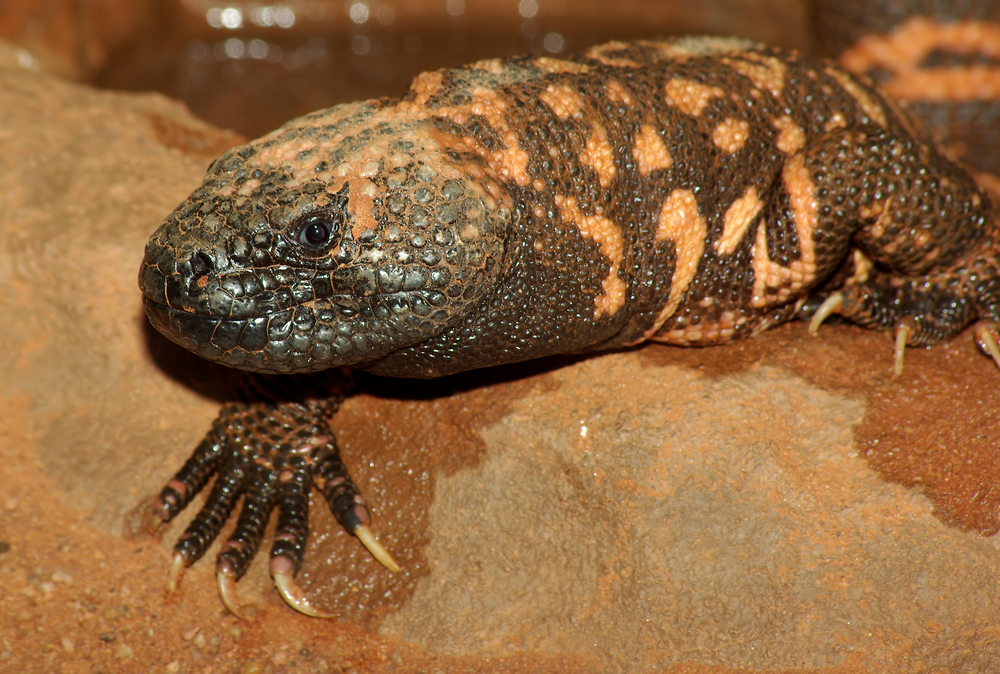Gila Monster Babies New Born Gila Monster Babies
Facts Near Gila Monsters

Gila monsters are the largest lizards native to the United States. They get their proper name from Arizona'due south Gila River basin, where they were first discovered. Gila (pronounced hee-la) monsters are also 1 of only ii venomous lizards in the world.
Size and clarification
Gila monsters have large and stout bodies with short, fat tails. They typically grow to around 20 inches (50 centimeters) and weigh around 4 lbs. (1.viii kilograms), according to National Geographic.
Their heads and necks are broad and their eyes are black with round pupils. Their bodies are covered with beaded scales and bright blackness, pinkish, yellow and orange patterns. Their broad feet end with long, abrupt claws.
Habitat
Gila monsters are but plant in the Sonoran, Mojave and Chihuahuan deserts in the southwestern Usa and northwestern United mexican states.
Gilas spend around 95 percent of their lives in their homes, which are secret burrows located in rocky foothills, according to National Geographic.
Habits
A group of these lizards is called a lounge, which is appropriate since they love to lie around and soak upwardly the lord's day'south rays. In fact, other than eating, sunbathing is the only reason a Gila monster will leave its home underground.
When a Gila monster is active depends on the weather. If it'southward a really hot day, the cadger may cull to but come out at night. If it's a cooler solar day, the other hand, the lizard may make an appearance while the sun is upward.
Offspring
Like other lizards, Gilas lay eggs. A female can lay three to thirteen eggs at a time, and she incubates them for effectually iv months. The eggs are ordinarily about 2.v inches (6.3 cm) long and weigh about 1.4 ounces (40 grams). At nativity, a baby Gila is around 6.3 inches (sixteen cm) long.
Gila monsters take three to five years to mature and live 20 to 30 years.

Nutrition
Gila monsters are carnivores, which means they eat meat. Since they are on the lazy side, they tend to adopt like shooting fish in a barrel casualty, such every bit eggs and newborn mammals. These animals don't even chew their nutrient and tin even swallow small eggs whole. Gilas may also eat frogs, rodents, insects, lizards, worms and feces.
If they tin can't leave of their couch to forage, no trouble. Gilas store fat in their tails and tin become for months without food. They particularly use this trait during the winter and volition stay within all season long.
When it does swallow, it goes big. A Gila monster can gulp down a third of its trunk weight in one repast, according to the San Diego Zoo.
Chewy bite
Gila monsters obviously use their venomous saliva for defense force rather than hunting, according to the Animal Diversity Spider web. When attacked, the Gila monster clamps downwardly and doesn't let go, according to the Arizona Poison and Drug Information Center. The toxin comes from the glands in their jaws, though grooves in the animal'due south teeth into the broken skin of its victim. Gilas chew into the mankind to make certain the venom is deposited.
The bite is described as extremely painful, just the poison isn't mortiferous to humans in most cases. The pain is more often than not confined to the bite area, co-ordinate to Arizona's Poison Eye. Information technology also may cause localized swelling, nausea, vomiting, high claret pressure, weakness, faintness, excessive sweating, chills and fever.
Currently, there is no antivenom for Gila monster bites. The commencement stride to treatment is making the lizard allow become. A strong stick to pry autonomously the jaws is recommended. Start assistance may include irrigating the wound with water and immobilizing the affected limb at heart level. The wound should exist checked for broken teeth. Anyone bitten past a Gila monster should seek firsthand medical treatment.
Classification/taxonomy
Hither is the taxonomy data for Gila monsters, according to the Integrated Taxonomic Information Arrangement (ITIS):
Kingdom: Animalia Subkingdom: Bilateria Infrakingdom: Deuterostomia Phylum: Chordata Subphylum: Vertebrata Infraphylum: Gnathostomata Superclass: Tetrapoda Class: Reptilia Order: Squamata Suborder: Autarchoglossa Family: Helodermatidae Genus: Heloderma Species: Heloderma suspectum Subspecies: Heloderma suspectum cinctum (banded Gila monster), Heloderma suspectum suspectum (reticulate Gila monster)
Conservation condition
Gila monsters are listed as near threatened on the International Union for Conservation of Nature's Ruby-red List of Threatened Species. Information technology is estimated that the population is declining, though at that place are no exact numbers.
The United States and Mexico prohibit the collection of Gila monsters throughout their range, according to the IUCN. Sizable areas of habitat are protected from development in national parks and monuments and in federal wilderness areas.
Other facts
The other venomous lizard is the Mexican beaded lizard (Heloderma horridum), which is closely related (in the same genus). This lizard does employ its venom to kill its prey.
Gila monsters can only run almost 1 mph (1.half-dozen km/h).
Though non the most active animal, Gilas are more than willing to climb a cactus to get to a nest full of eggs.
The bead-like scales that cover Gilas are chosen osteoderms. The bright colors of these scales are thought to warn predators to stay away, much like the vivid colors of poisonous frogs.
Gilas use their big tails for balance while they walk.
There is a drug for the direction of Type 2 diabetes based on a poly peptide from Gila monster saliva. The drug has the nickname "cadger spit," co-ordinate to the San Diego Zoo.
Additional resources
- Potter Park Zoo: Gila Monster
- U.Southward. Library of Medicine: The Development of Byetta (Exenatide) from the Venom of the Gila Monster as an Anti-diabetic Agent
- The Atlantic: Arizona'due south Adorable Monster
Source: https://www.livescience.com/58379-gila-monster-facts.html

0 Response to "Gila Monster Babies New Born Gila Monster Babies"
Post a Comment